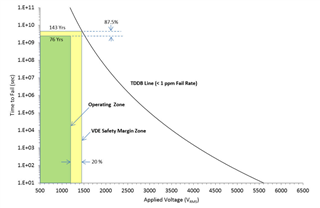Other Parts Discussed in Thread: AMC1336, AMC1411
Hello,
I have couple questions on Figure 6.5 from the datasheet.:

- As far as I know DIN VDE V 0884-11 defines reinforced isolation working voltage as where insulation has 37.5 years lifetime with 1ppm failure rate under ([working voltage] x 1.2) stress. Then why is the lifetime graph on the datasheet is given for 76 years and not 37.5 years? It looks like at 37.5 years the rating would be higher than 1.2kVrms.
- I see 143 years at ~1.5kVrms. Then At 1.2kVrms I see 76 years lifetime. I understand the safety factor on the voltage, but I would expect the lifetime to be greater at the lower stress. Where does 76 years value come from with respect to 143 years?
- If I need 10 years lifetime instead of 76 years, can I simply assume that the device can handle higher than the specified "Maximum-rated isolation working voltage" for my lifetime requirement? Or should I never exceed "Maximum-rated isolation working voltage"?
Kind regards,
Zeki

